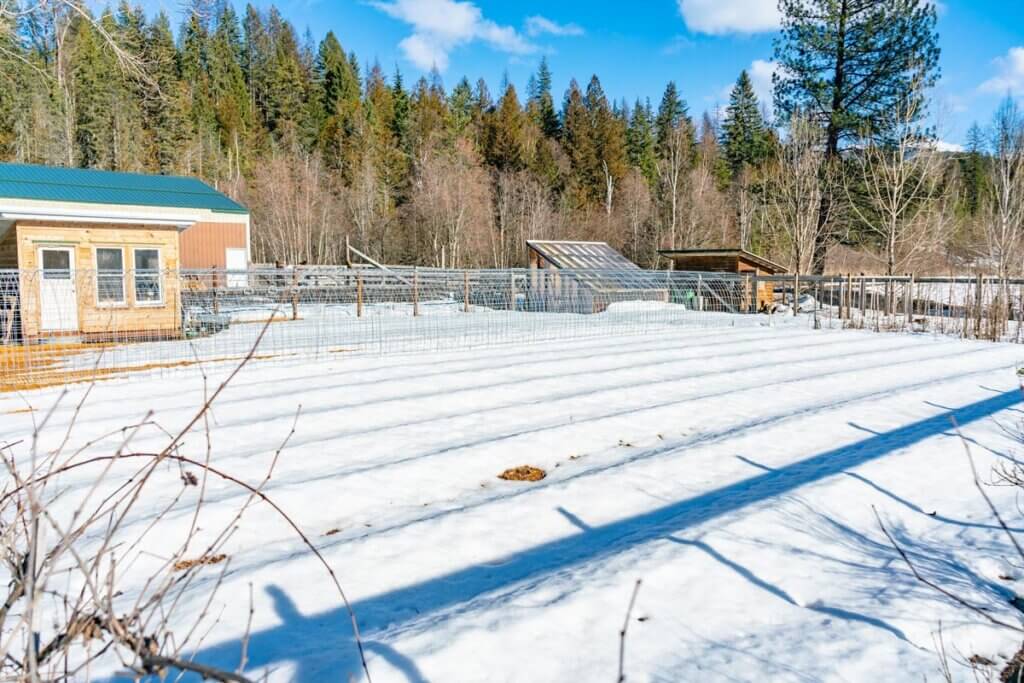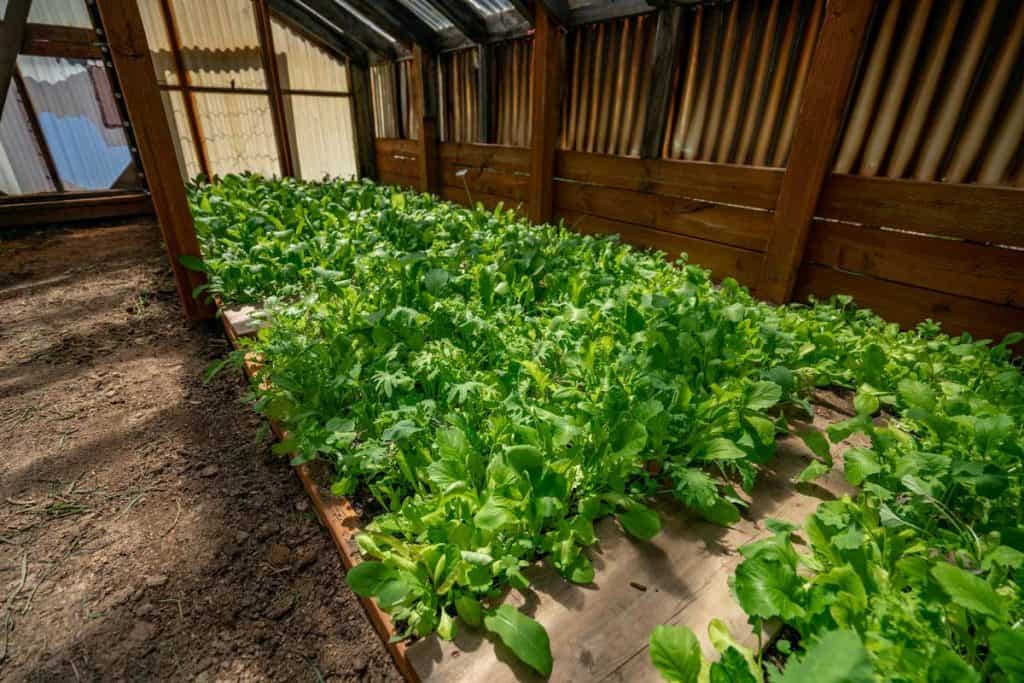
If you find the rising cost of your electric bill in the winter months creates a need to find a better way to heat your greenhouse, you are in the right place. You can use this guide to learn how to heat a greenhouse without electricity, no matter how big or small it may be.

Why We Use a Greenhouse
Our family is blessed to live in North Idaho. We enjoy four seasons; each one is different with its unsurpassed beauty and grandeur. Some seasons are longer than others, and because of the seasons, we have to deal with a shorter growing season for the garden.
Typically gardening in winter with cold weather methods helps us get a jump start on early spring gardening. Also, knowing how to start seeds indoors and spring garden planning tips and tricks helps extend our growing season.
We also build a DIY hoop house greenhouse each season which increases our options to affect the amount of food we grow, accommodating the needs of our growing family.
We have learned through trial and error what crops will not survive a frost. The longer we can extend our growing season, the hardier our plants become for our garden beds, and we attribute this to an early, well-established start in a greenhouse-type environment.

Learning How to Heat a Greenhouse
Being able to grow greens year-round and creating a healthy microclimate to successfully start plenty of seedlings is more economical when growing a year’s worth of food for our family.
Greenhouses in colder climates have difficulty staying warm with proper humidity, sunlight, and optimal temperatures (62°F to 76°F), with nighttime temps no lower than 45°F. This makes learning how to heat a greenhouse in winter and early spring critical.
Benefits of a Greenhouse Without Electricity
Living in the Northwest, it’s not uncommon to lose power during a winter storm. Knowing how to prepare for power outages is helpful on the homestead. Heating a greenhouse without electricity makes one less thing to worry about in these situations.
There are many things to consider before going off-grid, and not using electric heaters as a heating system for your greenhouse may not be for you. However, you can still enjoy the health benefits of going off-grid if you incorporate a hybrid approach with some of these eco-conscious and money-saving methods.
Importance of Humidity Control
Humidity control is an important factor in a greenhouse that nurtures plant life. Humidity should be around 70-80 percent, and this can be challenging to maintain in colder climates.
A well-insulated greenhouse will help prevent heat loss and maintain constant temperature and humidity. You want the proper balance of heat and humidity without creating an atmosphere where molds or fungi can grow.
Homesteading Hack: Running a small fan for a couple of hours daily for air circulation is helpful, but this may require electricity.

Ways to Heat a Greenhouse Without Electricity
There are numerous options to keep a greenhouse warm. Finding the best option for you while waiting for those sunny days of summer is a personal and economic decision.
Insulation
Insulation is a key component to utilizing whatever heat source you choose. Straw bales, stones, rocks, soil or water create passive solar heat.
When you fill plastic 5-10 gallon containers painted black or 55-gallon drums with water, placed on the north side of the greenhouse (so they don’t shade the plants), the water heats up during the day, creating a thermal mass that continues to release residual heat during the night.
Glass or clear plastic used for the walls and roof will allow essential sunlight and heat to penetrate the greenhouse as well.
Homesteading Hack: Double up on plastic, and seal all the cracks or gaps. Also, the sun doesn’t shine on the north side of a greenhouse for those in a northern climate, so completely insulating that side with a solid wall is beneficial.

Make Compost
This is one of the easiest ways to heat a greenhouse without electricity, especially if you use our home compost troubleshooting & FAQs to get you started.
Creating a hotbed using organic materials from a DIY composting pile is an economical way to generate heat for your greenhouse and supercharge your soil for future planting in a raised bed or traditional garden rows.
Add an Animal Hutch
In addition to using chickens to restore the land, you can put chickens, rabbits, or other small farm animals to work in your greenhouse.
Setting up their habitat in your greenhouse generates body heat (manure generates heat, too) and humidity for your plants. It’s double-duty, economical and utilizes space well.
Homesteading Hack: The important thing to remember using this method is to keep a strong barrier between the animals and plants, or they will consume everything you have planted.

Below Ground Greenhouse
Geothermal options to heat a greenhouse can be more work but well worth the money you save by using consistent ground temperature and sunlight to heat your plants.
Walipini, meaning “place of warmth,” is a greenhouse built in the ground below the frost line.
The labor-intensive work of digging down six to ten feet with a sloped dirt floor and hard-tamped dirt walls (to prevent water seepage), then roofing with glass or plastic, may prove economical yet harder to manage.
Solar Panels
If you live where there is plenty of sunshine year round or even minimal sunshine for a few months of the year, solar panels can be a good economical option.
The initial cost of solar panels, batteries, and inverters needed to heat the greenhouse can be expensive, but it is a good way to utilize the sun’s power and grow healthy plants.

Reflect the Light
Your greenhouse should be situated where it receives the most sun and light possible. South-facing is best; clearing away any tall shrubs, trees, or other objects that may diffuse the southern exposure is helpful.
Transparent materials that reflect the most light are glass and plastic (even bubble wrap) on the sidewalls and roof. They bring in that glorious heat from the sun, bringing life and growth to your plants.

Homesteading Smaller Plots of Land
We have given you some ideas on how to heat a greenhouse without electricity. What if you live somewhere that doesn’t have the space to have a greenhouse? Are there other ideas you can use to grow food year-round and create a smaller-scale greenhouse theory option?
Our gardening in winter (cold weather growing methods) has some great tips and tricks to teach you how. Join us as we talk to Rick Stone from Our Stoney Acres about season garden extenders in our Pantry Chat Podcast.

More Articles You May Enjoy
- How to Build a DIY Hoop House Greenhouse
- Gardening in Winter (Cold-Weather Growing Methods)
- Get a Jump Start on Early Spring Gardening
- Learn How To Start Seeds Indoors
- Spring Garden Planning Ideas, Tips & Tricks
- Crops That Will NOT Survive a Frost
- How to Grow Greens Year Round
- How to Grow a Year’s Worth of Food
- Permaculture Design + Mistakes to Avoid


















